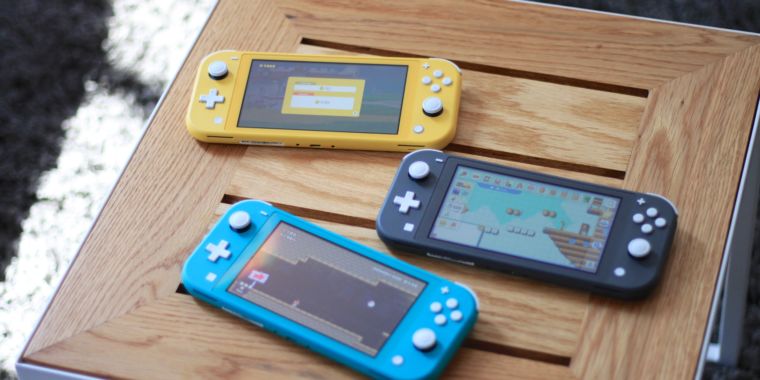20 percent of Switch sales now going to households that already had a Switch
[ad_1]
-
Congratulations! It’s a bouncing, baby gaming console!
-
A nice tricolor gaming salad.
-
If Switch players can get the d-pad back, maybe iPhone users can get the headphone jack back one of these days?
Nintendo -
The controls may look a bit bigger, but it’s just an optical illusion created by the smaller system housing.
Nintendo -
Compare and contrast the directional inputs, but also note how much less “wasted” space there is on the bottom of the control area.
Nintendo -
The shoulder buttons have not been shrunk or squeezed in any way, and reaching them feels a bit more natural thanks to the Lite’s shorter height.
Nintendo -
Both systems have USB-C ports on the bottom, but only one lets you connect to a TV display.
Nintendo -
While it’s much smaller in other dimensions, the Switch Lite is not significantly thinner than the original.
Nintendo -
Check out the redesigned cooling grates as you compare and contrast the sizes.
Nintendo -
Dude, where’s my kickstand?
Nintendo -
A new SD card slot replaces the opening that used to be behind the kickstand.
Nintendo -
Down in front!
Nintendo -
The higher PPI supposedly makes the image on the bottom a tad sharper than the one on the top, but we couldn’t see much difference.
Nintendo
In the last year, Nintendo sold roughly 5.8 million Switch units to households that already had at least one Switch. That’s according to a recently translated investor Q&A in which Nintendo President Shuntaro Furukawa said that “household demand for multiple systems accounted for roughly 20% of [28.83 million] unit sales of the Nintendo Switch family of systems” for the fiscal year ending March 31.
While Nintendo said in 2019 that “some households have already purchased multiple consoles,” this is our first concrete look into just how much multi-Switch households are contributing to the Switch’s sales, which now amount to over 85 million units over the system’s lifetime. And Furukawa thinks the trend of multi-Switch households is only set to increase.
“Going forward, we expect demand for multiple systems per household will increase even as hardware unit sales grow,” he said. “By region, significant sales growth is continuing in Asia, and we believe there is still room for sufficient growth of new demand in Europe and the United States, considering the sizes of those populations. To this end, we must thoroughly convey the appeal of existing titles and future titles to consumers.”
Nintendo’s plans for the Switch have always involved selling more than one system to some families. Then-President Tatsumi Kimishima said multiple times in 2018 that he expected many households to buy multiple Switch consoles for separate family members.
“Our ultimate ambition is for a Nintendo Switch to be owned not just by every family, but by every single person,” legendary Nintendo designer Shigeru Miyamoto also said in 2018. That echoes a quote Miyamoto gave The Economist in 2009, when he said that “instead of selling one unit per household as with the Wii, Nintendo wants to sell one DSi per family member.” Nintendo probably met that promise in many Japanese households, considering the company sold over 32 million Japanese DS systems to a country that had roughly 53 million households as of 2015.
Just as the portable DS encouraged families to purchase extra systems for separate family members, the late 2019 release of the lower-priced, portable-only Switch Lite probably increased the appeal of a second Switch in some households. The Lite was responsible for 8.51 million sales in the 2021 fiscal year and 14.7 million total sales so far in its lifetime.
Unfortunately, managing more than one Switch in a single household is not a simple process. A secondary system using the same Nintendo account requires an online check-in every time a game is launched, and it can’t run downloaded games at all if another user on that same account is playing at the same time. On the plus side, sharing save data between multiple Switch systems has become much simpler since Nintendo introduced cloud saves as part of its $20/year Switch Online subscription service.
Elsewhere in the Q&A, Furukawa reiterated concerns that a global shortage of silicon chips could impact production of the Switch this year. “Demand for hardware continues to exceed our expectations even after the beginning of this calendar year, and production has currently not caught up to this high demand due to the tight supply and demand situation for semiconductor materials worldwide,” he said. “Although we are currently striving to produce as many units as possible, the fact is that our production plans are more uncertain than they were at the beginning of previous fiscal years.”
Listing image by Nintendo
[ad_2]
Source link




